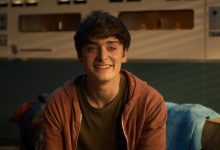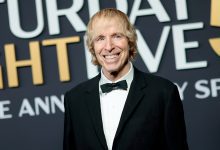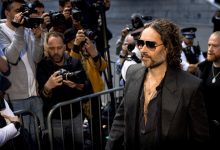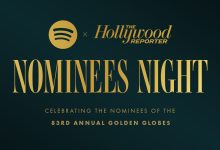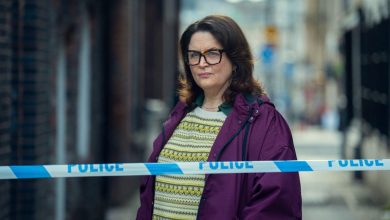Inside ‘Megadoc’: How Francis Ford Coppola Made Mike Figgis an Offer He Couldn’t Refuse
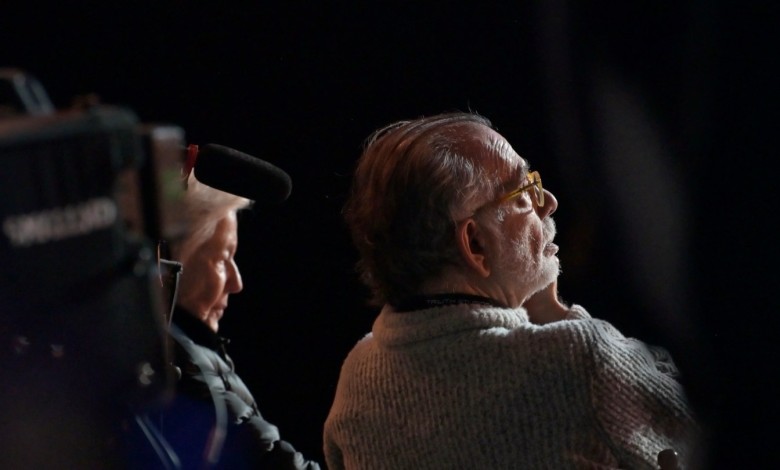
When Francis Ford Coppola finally went into production on Megalopolis, the project carried the weight of decades of anticipation and the air of a high-wire act undertaken by a beloved, daredevil octogenarian. At 83, Coppola was committing more than $140 million of his own fortune to a film that the studios had long deemed too bizarre and risky. The scale was staggering for an independent production, the ambition unbounded — and Mike Figgis happened to be there to document it all.
Figgis, the British filmmaker behind Leaving Las Vegas and a string of digital experiments, arrived on set almost by accident. He had met Coppola decades earlier while shooting his Oscar-winning drama with the great director’s nephew, Nicolas Cage. The two stayed friendly. When Figgis heard Coppola was returning to the director’s chair, he sent him a casual note of congratulations, adding an offer to “be a fly on the wall.” Months later, a characteristically offhand reply arrived: “Sounds good. Could you be here in three weeks?” With no contract and little preparation, Figgis boarded a plane and embedded himself in the production of Megalopolis for the full ride.
The resulting movie, Megadoc, premieres Thursday at the Venice Film Festival. Eschewing the polished, hagiographic style of many contemporary making-of documentaries, Figgis keeps his footprint small and his perspective immediate. He captures Coppola at work in the present tense — navigating the tensions and tedium of a massive VFX-heavy production, clashing with collaborators (especially his supporting star Shia LaBeouf), and, at times, appearing to thrive on the chaos of near-disaster. Moments of conflict and exhilaration unfurl in equal measure, from the firing of key creative personnel to the strange camaraderie that develops between Coppola and his cast — a lineup that includes candid moments with Adam Driver, Aubrey Plaza, LaBeouf, Nathalie Emmanuel, Dustin Hoffman and Jon Voight. What emerges is a portrait of Coppola as a veteran artist both liberated and beleaguered: free of any form of oversight yet hemmed in by the logistical demands of the very Hollywood machine he helped invent.
The Hollywood Reporter connected with Figgis over Zoom ahead of Venice to discuss Coppola’s appetite for chaos and why he believes Megalopolis will endure as a landmark of experimental cinema despite its harsh reception from many critics.
So, how did you end up on the set of Megalopolis?
Well, I first met Francis around the time of Leaving Las Vegas through Nicolas [Cage], because of the family connection, and we kept in touch over the years. He once came through London and we had a highly entertaining evening together, and years later he invited me to serve as a guest art director for an edition of All Story, the literary magazine that he publishes out of Napa. Some time later, I was corresponding with the magazine’s editor and he mentioned that Francis was finally moving ahead with making Megalopolis. I had no idea what Megalopolis even was, but I looked it up and read about what a big ambition it was for him, and how he had been trying to make it for years. So I wrote him a little note saying, “Francis, I heard you’re doing Megalopolis. Congratulations, that’s fantastic news.” And then I added a cheeky PS, saying, “By the way, if you want someone to document the process as a fly on the wall, you know how to find me.” And then I heard nothing back. A long time later, out of the blue, I got an email saying, “Hey, sounds good. Could you be here in three weeks for the start of pre-production?” There was nothing remotely formal about the offer. He just said that if I wanted to do a doc, he’d talk to the producer and make sure I had whatever I needed. It was all very Francis’s style. I cleared my schedule and jumped on a plane.
How did you find your footing on the production and figure out what your story would be?
Well, I started off with nothing and went into it with a totally open mind. I really detest the way so many documentaries are made these days — especially for streaming — where they find a big, hot subject that’s trended online and develop what’s basically a detailed feature script. Then the money people read and approve that, and they gather a bunch of Arris to shoot in a high-gloss style, slap some terrible music on it, and call it a documentary. I would rather stick pins in my eyes than do that. So I went in there with just one assistant, who’s also my producer, and we spent the first couple of weeks figuring out the best way to shoot this. I started with a relatively big camera, but it was immediately apparent that I needed to be as small and unobstrusive as possible. Francis gave me permission to go wherever I wanted, but it was important to have a small footprint, so I was agile and wouldn’t get in the way. I realized pretty early on that the story I wanted to tell was about the process of filmmaking — not Francis’s legend, but the action of him making this movie. There’s a quote from the artist Ad Reinhardt, which I love, where he says, “The business of the painter is paint brushes.” I love documentaries that are about process. One of my biggest influences when I was first starting to make films was reading Lillian Ross’s book, Picture, which was a journalistic deconstruction of the making of John Houston’s Red Badge of Courage. I felt that would be a good template. With Francis, there is a lot of amazing archival material for contextualizing him, but during the edit, I ended up cutting a lot of that stuff out. It’s fascinating material, of course, but it immediately puts the audience in a reverential, archival mode, and I wanted the film to be much more in the present tense. Like, what’s going on with Francis today, at age 83, as he spends $140 million of his own money to make this monumental passion project while reckoning with all of the realities of today’s film industry?
At one point in the doc, you remark to the camera how “all of the great documentaries about filmmaking are about disasters,” and you observe that you’re finding yourself perking up, or even getting a little excited as a storyteller, when things on set start to get contentious — because, naturally, it’s good material. At the same time, it’s clear that you’re building bonds with a lot of the people you’re filming during their many long shooting days.
Yeah, sometimes it was a little complicated. But overall, my personal experience was of waking up feeling incredibly cheerful. Because I had an amazing revelation early on: I was doing what I love — directing a film — but none of the hugely stressful creative challenges I was observing were my responsibility. None of it was ultimately my problem. That felt amazing [Laughs]. Of course, I grew to like a lot of these people, and I hoped that things worked out for them, but my ass wasn’t on the line. At the same time, I developed interesting relationships with the amazing crew members Francis had assembled. He never introduced me or anything, so initially, a lot of people on set viewed me warily — especially the actors — but over time, we got to know each other. So we were grabbing beers together after wrap, or exploring new restaurants in Atlanta. As the director on my own films, you never have time and energy to do that kind of thing, and no matter how close you become with your collaborators, there’s a hierarchy and a barrier between the director and his crew. It was great fun to be embedded in the middle of a huge production with all of those interesting people, but to have the freedom to just sort of hang out and observe.
So, what new things did you learn about Francis through the process of making this film?
Well, as I said, I knew him a little bit socially, and like everyone, I was an admirer of the mythology and the classic films. As part of my prep, I read Sam Watson’s book [The Path to Paradise: A Francis Ford Coppola Story] and his wife Eleanor’s very interesting and insightful book [Notes on a Life]. I got to interview Eleanor early on, before she passed away. I asked her for any advice [Eleanor Coopola shot most of the on-set footage for what would become the classic making-of doc, Hearts of Darkness: A Filmmaker’s Apocalypse]. She told me, “He’s going to change his mind about things all the time, so be there and be ready for that.” After a few weeks on set, I thought, “Oh wow, he really does.” There’s a moment in the documentary where I say, “You seem to thrive on chaos,” and he denies it. But it’s true, he absolutely does. He needs a kind of group energy of confusion, which is a reflection of what’s going on for him creatively in his mind, and he finds clarity through process. He likes having lots of people around to jive with — he gets energy from all of it, even the doubts and creative tensions.
There’s that moment right after he fires his VFX supervisor when the production designer also quits, and this hits the press in a very negative way. It appears as if the whole enormously expensive production could be teetering — but you say to the camera that Francis seems to have been energized by it all.
Totally. He was suddenly in a really good mood. Because in his mind, he had just solved a creative problem that was holding him back. Whether that was the truth is actually, in a sense, neither here nor there, because that’s part of the creative process for any artist — you create a world, you make your rules, and all of the cliches about how you have to follow your gut instincts are absolutely true. In Francis’s case, the stakes were just very high, because it was a such a big film. Nonetheless, he was suddenly very cheerful.
What were your thoughts in that moment, as a fellow director looking on?
Well, we know in hindsight that he wasn’t yet fully aware that he had created a lot of expensive problems for himself that were going to be hard to fix, because he had embarked on a film that aspired to a Marvel Cinematic Universe-degree of digital sophistication, and he was pulling the plug on a lot of that very late in the game. The interesting thing is that he chose to enter that world. You know, he hired the production designer who did Guardians of the Galaxy 3 [Beth Mickle]. He went down that path with full intention, thinking, “This is the way big films are done now and I’m going to explore it.” The other interesting thing, of course, is that he and George Lucas basically invented that technology. They set the stage for almost all of today’s digital VFX world, but it’s evolved to a very different level now.

Coppola and Figgis during the making of Megalopolis/Megadoc.
It was interesting how you said he feels that he needs a big production, because there were many moments during the documentary where it appears so clear that all of the infrastructure of studio tentpole-style filmmaking he has assembled is — quite tragically — not at all suited to his preferred style of filmmaking. He’s so improvisational and intuitive, and he thrives in the chaos, but he’s also deeply frustrated by all of the protocols and rigid planning that today’s VFX-heavy moviemaking requires.
Yeah, he’s constantly frustrated by having to wait around for set-ups. The irony is that he’s the one who ordered and is paying for all of these expensive, flashy things that require so much waiting time. He prefers the tactile feel and immediacy of practical effects, but he found himself somewhat wedded to a process that requires much more planning and rigidity. While I was there with my little camera, filming the doc in the background, I constantly marveled at the scale of the production, but also thought he would probably be having a lot more fun working with a much smaller set-up. Then he could have thrown his enormous amounts of money into a freer form of experimentation. But Francis is a legend and there’s a whole generation of these guys — Ridley Scott and Scorsese, too — who are like old generals. They need their army. But having that huge army requires a lot of planning, less improvising, and a lot of waiting around. I often wonder what it would be like to see those guys work on small films again. Francis still works in a very independent spirit, but doing so at this scale frustrated him constantly — and he was literally watching his own money burn every time he was stuck there waiting. Because all of the talented people he had pulled together — they were on his side, but no one was doing it for free.
How did your relationships with the actors on set evolve? There’s a lot of great stuff with Jon Voight, Dustin Hoffman and others, but Shia LaBeouf and Aubrey Plaza kind of steal the show and end up becoming Francis’s co-stars of the documentary.
Well, I tried to be very respectful of everyone’s process and to remember that these are not my actors. As I explain in the film, Adam [Driver] didn’t want me shooting him, which I could completely understand. You play differently when you’re performing your part for the camera and when you’re performing while a documentary camera also shoots you. I get that. Over time, everyone kind of figured out who I was and why I was there and I generally got along well with everyone. Aubrey and I connected on day one. She’s very mischevious and comedic, and when I showed up to film some of their rehearsals, she just grabbed me and ordered me to follow her around. She plays a newscaster in the film and I happened to be holding a camera, so she said, “You’re my camera guy; come with me!” And that was great for me, because it was my entree into those rehearsals when no one really knew what I was doing there yet. Jon Voigt was also very gracious and became part of my narrative. As for Shia, he just can’t help himself, but we got along great. He was genuinely afraid that he was going to get fired during the whole first phase of the film. But he’s got a mouth on him, and he was still confronting Francis all of the time. But he’s also really smart, and a lot of his feedback had an interesting logic to it. He drove Francis nuts, but you could tell that part of him also loved having a lead actor who really engaged with him. Eventually, they developed this competitive vibe, which was great fun to watch.
That transfixing moment where Aubrey Plaza challenges Dustin Hoffman to arm wrestle between takes was worth the full cost of admission for me. The chemistry they instantly establish is wild.
Yeah, that was a great moment. I really had to scramble to get a place to film it and not miss it, because suddenly everyone kind of gathered around to watch and the scene got really crowded. It’s one of my favorite sequences too.
So, what’s your assessment of the finished film? Is Megalopolis a good movie?
That’s the point. It’s not really about good or bad. It’s about trying something new. You know, Francis is in his 80s and he’s still pushing his own boundaries. He’s trying to express these crazy ideas he’s been thinking about for 30 years, and he’s paying for it all with his own money. He’s not beholden to anyone. So, you know, who gives a fuck? Money comes and goes. He’s had that attitude about money his whole life. If something doesn’t work, you invent something, you make some more money, you drink some wine, and you go back to creating. How can you not respect that? Some of the reviews and the coverage were so contemptuous. I really didn’t understand it. I can’t think of another filmmaker who has anywhere near his level of respectability within the cinema world who is still pushing himself that far outside his comfort zone. Name another director of that stature who is still trying to find totally new ways to express their ideas rather than just doing another conventional linear narrative. But there are indeed a lot of ideas in the film. It’s almost like it was made by a first-time filmmaker, where it suffers from that mistake so many of us make, where we think we might never get to make a film again, so we put every thought we’ve ever had into it. Personally, I kind of wish he had gone even further with the experimentalism and made it even more acidy and surreal.
Yeah, it sort of lands in an uncanny valley — between VFX-heavy studio-style filmmaking and a more experimental, non-linear tradition. But I have to say, I found it all exhilarating. Even when it was “bad,” it was bad in a completely original way. The optimism of the ideas also felt very out of step with the moment in a compelling way.
I made a documentary about the blues that Scorsese produced years ago, and I interviewed Peter Green from Fleetwood Mac, who famously did so much acid that he was a bit fried. Every time I asked him a question, he answered it with a complete non-sequitur. At one point, I asked him, “What was your first guitar?” And he says, “Well, the thing about music is, do you listen to the words first or do you listen to the tune?” It was a bizarre answer to that question, but it’s a great thought. A lot of young people I’ve talked to have said they found the ideas of Megalopolis really attractive, and they didn’t seem so concerned about how it’s stylistically caught between those two monoliths of filmmaking. They’re inspired by the film’s philosophical vision for the future, and how we might behave better towards one another. And, Francis being Francis, I know he’s already in the process of doing another edit for re-release. It will be exciting to see it.
Source: Hollywoodreporter
HiCelebNews online magazine publishes interesting content every day in the movies section of the entertainment category. Follow us to read the latest news.
Related Posts
- Emil Wakim Not Returning to ‘SNL’ After One Season: “Gut Punch of a Call to Get”
- E. Jean Carroll, Journalist and Trump Accuser, Has Cooperated With a Soon-to-Be-Unveiled Documentary (Exclusive)
- Jack Black, Fred Armisen, Margaret Cho Take on Go-Go’s Classics at Backyard Benefit
- Noomi Rapace as Mother Teresa in 'Mother.'
Courtesy of Venice Film Festival
…
- Brooks Nader Is Ready for ‘Love Thy Nader’ to Be Hulu’s Next Sister-Centered Reality TV Hit

